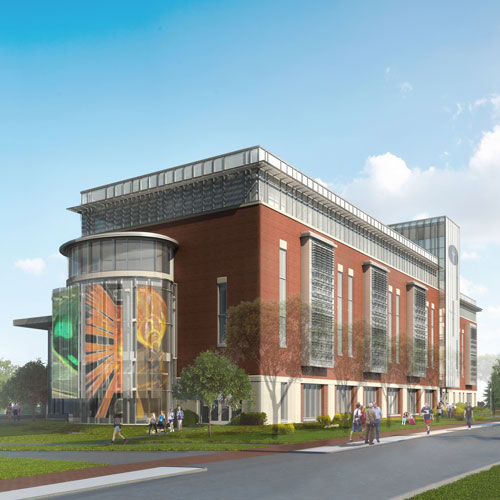In many ways, Internet giant Yahoo’s recently expanded data center in Lockport, New York, is an exemplar of modern high-tech wizardry. The site is one of five that house the sophisticated data servers and storage devices fueling the company’s search-engine, e-mail, photo, and social media services.
In contrast to the advanced technology it houses, though, one key design feature of the Lockport data center complex is decidedly low-tech: the facility’s structures, modeled after the humble chicken coop, are shaped to optimize the cooling power of ambient air flow, a far more energy-efficient cooling method than chilled-water systems.
The complex is composed of rectangular, prefabricated metal structures topped by cupolas extending the length of the buildings. Louvers built into the sides draw in cool air that is passed through the computing areas, and the structures are positioned to take in air on the two sides from which the prevailing winds most commonly flow. In each building, the air passes through two rows of cabinets and into a contained central hot aisle, which has a chimney on top. The chimney directs the waste heat to the top of the structure, where it can either be recirculated on cold winter days or vented through the cupola in warmer weather.
“This concept has been used for a long time in manufacturing facilities,” says Rich Kropfl, Yahoo’s vice president of data-center operations. And, in fact, Yahoo’s design was adapted from research by Tyson Foods on how to eliminate heat from a building. Data centers have temperature- and humidity-sensitive computing gear to protect, though, so Yahoo located its facility in a temperate area with moderate to low humidity. During the hottest summer days, an evaporative cooling system boosts cooling power, but it’s only needed about nine days a year, on average.
Automated sensors and controls help maintain optimal temperature and humidity ranges in the data center’s buildings, automatically adjusting the speed of the air handlers throughout the day. Under extreme conditions, sensors will send out alerts to ensure that the environment is modified appropriately with human intervention—a rare occurrence.
The Lockport site’s power usage effectiveness (PUE) is 1.08, compared to a range of 1.25–1.5 in data centers employing energy-hungry chilled-water cooling systems. This saves money, reduces carbon footprint, and conserves water (which is only needed on the nine or so days when the data center’s evaporative cooling system kicks in.)
“Core to Yahoo’s DNA is figuring out how we can continually be more efficient,” Kropfl says, and to this end, the company also does what it can to locate its data centers in areas where they can source green energy at low cost. In Lockport, locally produced hydropower is the predominant clean power source.

In addition to sustainability, building security was a top priority, given the site’s precious assets. Controls safeguard the entrances to each building, and inside, additional controls guard access to individual computer rooms and vault-like electrical and mechanical rooms. The facility does welcome visitors from the community on occasion, though. “That differentiates us,” Kropfl says. “Many data centers are like fortresses. We’re pretty open to the community.”
The site has hosted many groups of interested local officials and businesspeople, and the western New York region in general has embraced West Coast-based Yahoo. Particularly in and around Buffalo, New York, an area that has endured tough economic times in recent years, there’s a pride in hosting a major tech company. State and local tax incentives and the New York Power Authority’s support through expanded power capacity—to accommodate more than seven megawatts of demand—were key factors in Yahoo’s move to Lockport, and the $168 million expansion of the company’s complex there has created 115 new jobs, bringing Yahoo’s total job count in the area to 210.
Initial construction at the Lockport site began in 2010, the year Kropfl joined Yahoo. Prior to that, his career had been anchored in the financial-services industry, most recently with Bank of America. “It was a pretty big pivot,” Kropfl says, but he was able to navigate the new field thanks to his keen grasp of mission-critical systems.
A new experience was dealing with extensive permitting processes that entailed meeting with state and local officials and explaining the scope and goals of projects to the public. For the Lockport data center and other high-profile facilities, such matters take considerable time and effort to sort. “You can underestimate the number of interested parties,” Kropfl says.
When it came time to obtain permits for the expansion at Lockport in late 2013, it was almost like starting anew. “We couldn’t just take the process that we used in 2009 and repeat it,” Kropfl says. “There were different people and processes involved.”
To compensate for the lengthy permitting process, Yahoo’s crews employed a speedy construction strategy involving prefabricated sections. The new buildings took about a year to build, from December 2013 to the final test date in November 2014, and the complex opened as a model of efficiency, from its construction to its ongoing operation.


